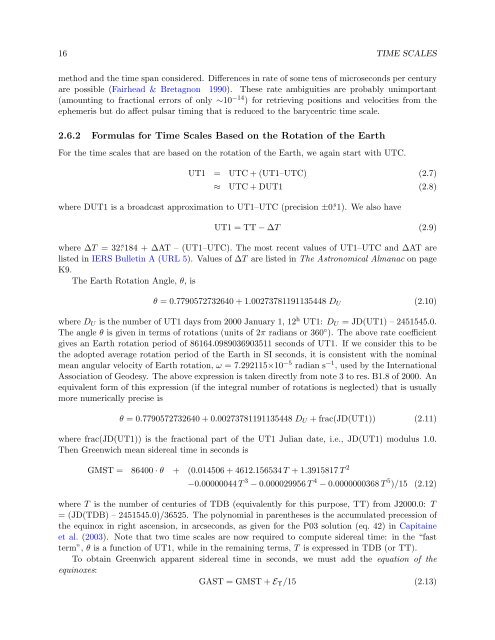USNO Circular 179 - U.S. Naval Observatory
USNO Circular 179 - U.S. Naval Observatory
USNO Circular 179 - U.S. Naval Observatory
You also want an ePaper? Increase the reach of your titles
YUMPU automatically turns print PDFs into web optimized ePapers that Google loves.
16 TIME SCALES<br />
method and the time span considered. Differences in rate of some tens of microseconds per century<br />
are possible (Fairhead & Bretagnon 1990). These rate ambiguities are probably unimportant<br />
(amounting to fractional errors of only ∼10 −14 ) for retrieving positions and velocities from the<br />
ephemeris but do affect pulsar timing that is reduced to the barycentric time scale.<br />
2.6.2 Formulas for Time Scales Based on the Rotation of the Earth<br />
For the time scales that are based on the rotation of the Earth, we again start with UTC.<br />
UT1 = UTC + (UT1–UTC) (2.7)<br />
≈ UTC + DUT1 (2.8)<br />
where DUT1 is a broadcast approximation to UT1–UTC (precision ±0. s 1). We also have<br />
UT1 = TT − ∆T (2.9)<br />
where ∆T = 32. s 184 + ∆AT – (UT1–UTC). The most recent values of UT1–UTC and ∆AT are<br />
listed in IERS Bulletin A (URL 5). Values of ∆T are listed in The Astronomical Almanac on page<br />
K9.<br />
The Earth Rotation Angle, θ, is<br />
θ = 0.7790572732640 + 1.00273781191135448 DU<br />
(2.10)<br />
where DU is the number of UT1 days from 2000 January 1, 12 h UT1: DU = JD(UT1) – 2451545.0.<br />
The angle θ is given in terms of rotations (units of 2π radians or 360 ◦ ). The above rate coefficient<br />
gives an Earth rotation period of 86164.0989036903511 seconds of UT1. If we consider this to be<br />
the adopted average rotation period of the Earth in SI seconds, it is consistent with the nominal<br />
mean angular velocity of Earth rotation, ω = 7.292115×10 −5 radian s −1 , used by the International<br />
Association of Geodesy. The above expression is taken directly from note 3 to res. B1.8 of 2000. An<br />
equivalent form of this expression (if the integral number of rotations is neglected) that is usually<br />
more numerically precise is<br />
θ = 0.7790572732640 + 0.00273781191135448 DU + frac(JD(UT1)) (2.11)<br />
where frac(JD(UT1)) is the fractional part of the UT1 Julian date, i.e., JD(UT1) modulus 1.0.<br />
Then Greenwich mean sidereal time in seconds is<br />
GMST = 86400 · θ + (0.014506 + 4612.156534 T + 1.3915817 T 2<br />
−0.00000044 T 3 − 0.000029956 T 4 − 0.0000000368 T 5 )/15 (2.12)<br />
where T is the number of centuries of TDB (equivalently for this purpose, TT) from J2000.0: T<br />
= (JD(TDB) – 2451545.0)/36525. The polynomial in parentheses is the accumulated precession of<br />
the equinox in right ascension, in arcseconds, as given for the P03 solution (eq. 42) in Capitaine<br />
et al. (2003). Note that two time scales are now required to compute sidereal time: in the “fast<br />
term”, θ is a function of UT1, while in the remaining terms, T is expressed in TDB (or TT).<br />
To obtain Greenwich apparent sidereal time in seconds, we must add the equation of the<br />
equinoxes:<br />
GAST = GMST + EΥ/15 (2.13)


